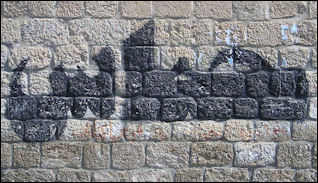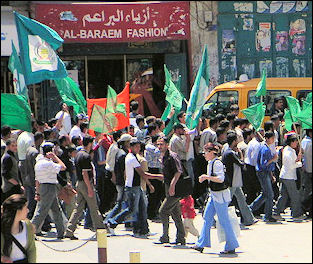TERRORIST-RESISTANCE GROUPS ACTIVE IN ISRAEL IN THE 1990s AND 2000s
Hamas The main terrorist groups that were active in Israel during a wave of violence there in the 1990s and early 2000s were: 1) Hamas; 2) Islamic Jihad; 3) the al-Aqsa Martyr’s Brigade; and 4) Hezbollah. They all had their flags, symbols, leaders, slogans and rituals and took more of an Islamist stance than Palestinian groups of the past such as the Palestinian Liberation Organization (PLO).
Hamas, Islamic Jihad and the al-Aqsa Martyr’s Brigade have their roots in first Intifada in the late 1980s and early 1990s when Palestinians began looking more to Muslim extremists groups for leadership, not just the PLO. During this time more Palestinians began showing up at mosques, women starting covering themselves more, liquor shops were closed and Islamic blocs began winning seats in local elections.
By the early 1990s these groups were attracting large, enthusiastic groups of followers and were staging suicide bomb attacks that left scores of Israelis dead and hundred wounded. Hamas, Al Aqsa Martyr’s Brigade and Islamic Jihad started out as rivals. Beginning in 2003 they began cooperated in suicide bombings and attacks of Israeli targets. The groups often have overlapping memberships.
Hamas
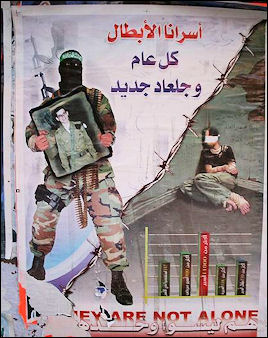
Hamas poster Hamas (an Arabic word that means “zeal,” and Arabic acronym for the group’s formal name, the Islamic Resistance Movement) is a militant fundamentalist Palestinian group that has carried a number of terrorist attacks on Israeli targets. After it began winning elections in Palestine it effectively switched from a terrorist group to a more conventional political party. The Hamas flag is green, the color of Islam.
Hamas has a political wing and a military wing. It has said it is committed not just to expelling Israel from the occupied territories but is also intent on destroying Israel, establishing an Islamic state based on Koranic law, disrupting the peace process and attacking perceived collaborators with Israel. One Hamas member told the Washington Post, “We can live with the Jews, but not in their own state. We will never surrender. It doesn’t matter if it takes another 100 years.”
Hamas was founded in 1987 in the Gaza Strip at the start of the Intifada as an offshoot of an Islamic social and welfare organization inspired the Egypt-based Muslim Brotherhood. Founded by Sheik Ahmed Yassin, Hamas, ironically enough, was originally supported by the Israelis as an alternative to the PLO. It also made contacts with the United States government.
In the early days Hamas was involved mostly on providing social services. Its militant activity was limited to Intifada stone throwing. It took up armed attacks in 1989 after a military wing was formed. At that time it lost support among Palestinian nationalists and Sheik Yassin was arrested, paving the way for younger, more radical members to move up the ranks.
In the early 1990s, as it took shape as a militant group, Hamas primarily went after Israeli military targets but after the attack in Hebron in 1994 that left 29 Muslim Palestinians dead it figured Israeli civilians were fair game. Hamas gained momentum and support as economic and political dividends from the 1993 Oslo peace accord failed to materialize and became a major force after the second Intifada broke out in 2000.
Hamas Organization and Social Services
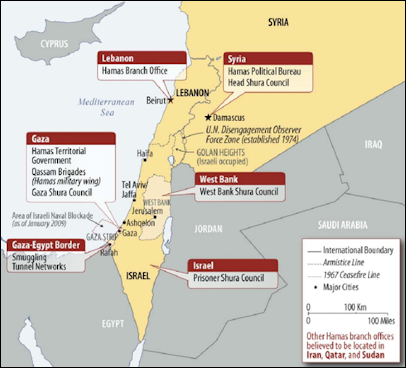
Hamas leadership Hamas was originally organized into four sectors: three in the West Bank and one in the Gaza Strip. Each had its own command and knew little of what the others sectors were up to and reported to leaders often based outside the country. The militants often mixed in with members who were involved in social services, religious activities and political organization and it was difficult for outsiders to tell who did what. Orders were often given anonymously with coded messages so it was difficult to determine who the leaders were.
In Gaza, Hamas gained support among the populace by providing social services such as clinics, schools, orphanages, food distribution centers, dairy farms, youth clubs, sports teams. It also provided financial support for Palestinians who had their houses destroyed or were wounded by the Israelis. The families of suicide bombers and people killed by Israeli raids were also given money.
Hamas ran the Islamic Charitable Society in the West Bank, which received millions of dollars from Saudi Arabia and had benefactors in the United States and other places. With its money it bought tons of flour, rice, noodles and other goods, which were stored in warehouses and then distributed among people in need. Large amounts of cash arrived from Islamic charities that receive donations from ordinary Muslims who are supposed to give around 5 percent of their income to charity. Some of the money donated for the social service wing was directed to the militant wing.
Sheik Ahmed Yassin
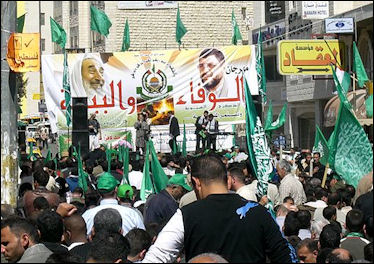
Sheik Ahmed Yassin was the founder, figurehead and spiritual leader of Hamas. A quadriplegic injured in a childhood soccer accident on a Gaza beach, he was bound to a wheechair, wore white robes and spoke so softly it was hard to hear him. Despite this his inflammatory words and spiritual wisdom inspired hundreds to rise up against Israel and join the Hamas cause. At one time he was believed to have been involved in Hamas terrorist activities.
Yassin was born in the Arab fishing village of Ashkelon in present-day Israel. He was in his teens in 1948 when Israel declared independence and was forced to flee to the Gaza Strip. He was arrested in 1989. A military court found him guilty of ordering the murders of Palestinians accused of collaborating with Israel. He received a life sentence and was imprisoned in a maximum security prison.
Yassin was released from prison in a swap for Mossad agents captured in a September 1997 botched assassination attempt in Amman, Jordan. He was received a hero’s welcome in Jordan. He later moved to Gaza City, where he was placed under house arrest in 1998, 2001 and 2002 by the Palestinian Authority. In 2003, Yassin said he was willing to declare a 10 year truce if Israel withdrew from the occupied territories. Israel declared that his proposition was ridiculous.
Yassin was nearly blind, nearly deaf and suffered from a number of ailments. He blamed his hearing loss to ear infections he suffered in his eight years in Israeli prisons. Israel has called him the “godfather of terrorism” and designated him as “marked for death.” He was ultimately assassinated in an Israeli missile attack.
Hamas Leaders in the late 1990s and Early 2000s
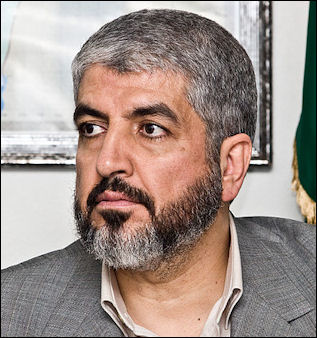
Hamas's Khaled Meshaal The political wing of Hamas in the early 2000s was headed by Khaled Meshaal. He was also active in the military wing. Based in Qatar and Syria, he survived a Mossad assassination attempt.
Mussa Abu Marzuk was the Hamas “foreign minister” and helped establish the group and win support for it from abroad. Born in a Gaza Strip refugee camp and inspired by the Muslim Brotherhood in Egypt, he worked with Yassin to make Hamas a credible organization. He created the group’s first political wing office and was arrested in the U.S. under pressure from Israel and spent 22 months in a U.S. prison and then was sent to Jordan.
The military wing of Hamas was headed by Salah Shehada. Declared by Israel as its No. 1 enemy, he strengthened the Hamas terror cells, increased the power of its bombs, and is believed to have been the mastermind behind a number of suicide bombings and attacks against Israeli soldiers. He was killed in late July 2002.
Mohammed Deif was one of the most wanted men in Israel. He was Hamas’s chief bomb makers and was responsible for scores of deaths. He eluded capture for more than a decade, living underground since 1992, and has escaped at least two Israeli assassination attempts, including a missile attack that caused him to lose one eye. He periodically released tapes condemning Israel. .
Abdel Aziz al-Rantisi was as the leader of Hamas after Yassin assassinated and served for a couple of months until he was assassinated in April 2004. He was an Egyptian-trained pediatrician. He was a particularly hard-line Muslim extremist and spent seven years in Israeli prisons.
Hamas Members and Supporters
Hamas rally in Bethlehem In the early days Hamas recruited young men through mosques, charitable foundations, schools and sporting clubs they ran. Most members were Palestinians from the West Bank and Gaza Strip but some were Arabs in Israel. Hamas representatives were well represented in local government and university councils. Hamas has offices in Damascus, Khartoum and other cities in the Middle East. Its rallies at home have featured parades of masked gunmen firing automatic weapons and displaying rocket propelled grenades.
Many early members of Hamas were attracted by the group’s piety and commitment while being disappointed with the PLO’s and Fatah’s corruption, immorality, snobbiness and ineffectiveness. One early Hamas member who encountered both Hamas and Fatah members in prison, told the Washington Post, “I found a big difference between Hamas and Fatah. During the holy days of Ramadan, the Fatah leaders did not fast, did not pray. Yet they criticized Hamas and Islamic Jihad as if they were the enemy, not the Israelis...On the Hamas side there was more cooperation and good feeling. They made me feel welcome. They offered me food and clothes. I felt like they cared about me and I started becoming Islamicized.”
Only the most dedicated Hamas recruits were allowed into the cells that planned and executed the attacks. Many of these include hardened members who were recruited from the prisons. These cells were hard for the Israelis to infiltrate and if members were lost they were easily replaced from a seemlily inexhaustible pool of militant wannabes.
Hamas cell members received advanced weapons training and used weapons smuggled in by Bedouins. Some are believed to be have been trained at camps in Lebanon and Afghanistan. New recruits were taught discipline and self respect by teachers who also served as role models. Students in Hamas-supported schools are still taught Hamas and Muslim extremist propaganda and idolize suicide bombers. Bachelor parties for Hamas members feature banners with gun-toting terrorists and bands that play songs about suicide bombers and martyrs to the Hamas cause.
Hamas has strong support among a large segment of the Palestinian population, particularly those who have been fed up with Palestinian Authority corruption, the failure of the peace efforts and harshness of the Israeli occupation. Polls in 2002 showed that Hamas had more support than other group, including Arafat’s Fatah party. The core supporters are members of the educated classes in Gaza. In the 1990s, Hamas began getting support from the Muslim Brothers in Jordan and Muslim extremists returning from the war in Afghanistan.
Hamas receives financial aid from Iran, Saudi Arabia, other Persian Gulf states and sympathizers in the Middle East, Europe and the United States. In the early 2000s it got about $20 million to $30 million a year from Iran. It also gets millions from the Texas-based Holy Land Foundation, a charity founded in in 1989 to help Palestinians in the West Bank and Gaza Strip. As part of a counter-terrorism operation in 1998, the FBI sent cash to Hamas to see if the group would divert the money from charitable purposes and use for a terrorist attack.
Hamas, the PLO and the Palestinian Authority
Bethlehem election posters Hamas began challenging the PLO for authority within Palestine in the 1990s. It demanded a much harder line against Israel and wanted to continue the terrorist campaign against the Israel when the PLO called for a cessation of violence.
The extent of the relationship between Arafat and Hamas was unclear. He was careful in his dealing with Hamas. If he let the group alone, the Israelis held him responsible for their violent acts. Arafat once said that Hamas suicide bombs are a “serious and dangerous terrorist act.” But if he cracked down too hard Hamas could target his government or even trigger a civil war with the Palestinian territories.
Hamas supporters staged protests denouncing the Palestinian Authorities for kowtowing to Israel and calling for the arrest of Arafat and his cronies on corruption charges. When Fatah was in control of the Palestinian Authority Hamas members clashed with Palestinian police and some members of the Palestinian police were arrested for not carrying out orders to arrest Hamas members. The Israeli government and the Palestinian Authority have cooperated in efforts to arrest Hamas members.
Sometimes Palestinian authorities rounded up and imprison suspected Hamas members and then quietly released them a short time later or released them to make a political point in response to something the Israelis did that the Palestinians didn’t like.
Hamas Terrorism and Violence
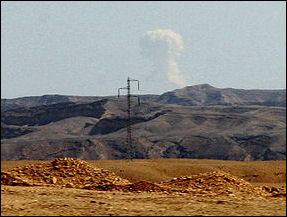
Hamas rocket explosion Hamas carries out attacks against Israeli soldiers and Jewish settlers, staged drive-by shootings and ambushes but was best known for its suicide attacks against civilians. Hamas was responsible for about half of suicide bombings carried out against Israeli targets in the 1990s and 2000s. Yassin said: “The Palestinian people are forced to defend themselves. The Palestinian people do not have Apache helicopters, or F-16s ir tanks or missiles. The only thing they can have is themselves to die as martyrs.”
Hamas leader Hassan Salameh told the Los Angeles Times, that Hamas “has to fight for Islam and not only for nation and the land.” He also said: “In order to get the truth out of suspected collaborators when we interrogated them we used to break their legs and arms with iron bars and chains and to stab them with knives. It was not cruelty for its own sake, but the way an underground organization has to operate in occupied territory.”
The Qassam Brigades is the militant wing of Hamas. It is believed to have had only 200 or 300 members at its peak and they operated in largely autonomous and secretive cells. The group is name after Iz al-Din al-Qassam, an Islamic preacher and rebel who fought against the Jews and the British in the 1930s and was killed by British forces in a village near Jenin. The Qassam Brigade carries out suicide bombings, bombing and shootings and stabbings. Most of the suicide bombing were carried out by volunteers who were given some training and then sent on their missions. There was never a shortage of volunteers.
The first Hamas attacks in the early 1990s were stabbings of Jewish settlers in the Gaza Strip. Not long after that they began carrying out bombings and suicide attacks against soldiers and later Israeli civilians and Palestinians that supported peace with Israel. Suicide bombers were treated as heros. Their picturers were plastered on billboards. Hamas stopped doing this for a while after Israeli intelligence began tracking down relatives and associates of the bombers.
Hamas terrorists carefully selected their targets and gathered intelligence. They operated in independent cells that were not aware of what other cells were doing. Cell members were often masters of disguise. Some reportedly dressed up like Jewish settlers and drove through checkpoints in vehicles with bumper stickers that read “Prepare Yourself for the messiah.”
Hamas Bombmakers
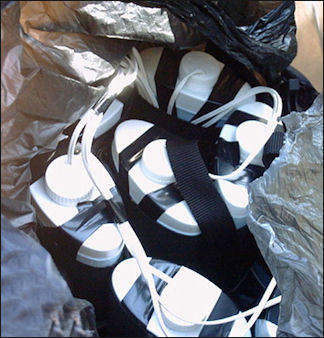
suicide bomb found by Israel Defense Forces Hamas had highly skilled master bombmakers working in the West Bank and the Gaza Strip, who made bombs, suicide bomber vests, mortars and rockets. Over the years the quality of the bombs improved as the amount of urea — which makes the bombs more powerful and stable — was increased . Hamas released videos on how to make homemade bombs and sometimes made bombs for other groups.
Hamas bomb-maker Yehiya “the Engineer” Ayash is believed to have masterminded at least seven suicide bombing in 1994 and 1995 that killed 52 and injured about 300. He was assassinated.
Hezbollah supplied Hamas with suicide bomber belts and gave them the know-how to make their own mortars. They also reportedly bought plans for North-Korea-designed rockets and passed on the designs to Hamas. A Hamas engineering wing built rockets from the designs that had a range of three miles and were used against Israeli targets.
Islamic Jihad
Islamic Jihad was founded in the 1970s in Egypt. Like Hamas, it wanted to destroy Israel and establish an Islamic state in what is now Israel and the Palestinian territories. It received money from Iran and training from Syria and acted, it said, without any connections to the Palestinian Authority. It was hardest group for the Palestinian Authority to control. .
Islamic Jihad is regarded as a sister organization of Hamas. Unlike Hamas it is strictly a militant operation. It didn’t have a significant country wing or run charities or offer social services. Islamic Jihad has a small membership, with around only 70 to 100 militants. According to polls in the early 2000s it was supported by only around 10 percent of the Palestinian population. It’s symbol is a black banner.
In Egypt Islamic Jihad is one the two largest violent Islamic groups. Its goals are making making Egypt an Islamic state through violent means, ousted the secular government and implementing Sharia (Islamic law). According to one Egyptian scholar, it wants to rule with a "religious authority based on religious texts and under slogans that only God, not men, will rule."

Egyptian Islamic Jihad was founded by Dr. Ayman Rabi al-Zawahiri, Osama bin Laden’s right hand man and the current leader of Al-Qaida. Two other high ranking Al-Qaida members: Fahmi Nasr (a.k.a. Mohammed Salah) and Tariq Anwar were leaders with Islamic Jihad. Egyptian Islamic Jihad was involved in the assassination of Sadat. In an anti-terrorism speech, U.S. President George Bush mentioned the Egyptian Islamic Jihad by name.
In 2002, Islamic Jihad was headed by Ramadan Shallah, a former Florida State University professor, who was based in Damascus. In October 1995, Islamic Jihad’s leader, a Palestinian named Fathi Shkaki, was murdered by two Mossad agents on motorcycles outside a hotel in Malta. He was replaced by Sheik Abdallah al-Shami, who worked out of Gaza.
Islamic Jihad did its first suicide bombing in 2000. It was responsible for a number of attacks in 2001 and 2002. In the 2000s Islamic Jihad carried out about 30 percent of the suicide bomb attacks against Israeli targets. It focused strictly on attacks, many of them suicide bombings. It has collaborated with other organizations.
Al-Aqsa Martyrs Brigades
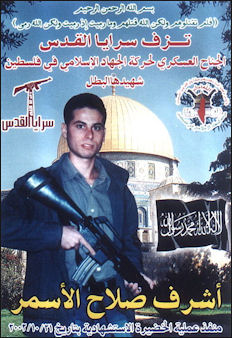
The Al-Aqsa Martyrs Brigades is a militant group that emerged out of Yasser Arafat’s Fatah organization after the beginning of second Intifada , which began after Sharon’s visit to the Temple Mount in September 2000. Joining Hamas and Islamic Jihad as sources of suicide bombers, it is named after Al-Aqsa Mosque in the Temple Mount in Jerusalem, where the second Intifada began.
Al-Aqsa Martyrs Brigades was allowed to form under Arafat within Fatah to address the political threat presented by Hamas. The goals of Al-Aqsa Martyrs Brigades are more modest than those of Hamas and Islamic Jihad. They are not committed to driving the Israelis out of Israel and Palestine. Rather they want to pressure Israel into withdrawing from the Palestinian territories and forcing Israel to make concessions on the negotiating table.
Fatah is Arafat’s party and the oldest Palestinian political organization. It was the main faction of the PLO. Fatah is largely secular and has traditionally been left-leaning. Fatah was divided in the 1990s and 2000s by disputes between the so-called Old Guard — veteran PLO politicians — and the New Guard — young activists. Fatah comprised of the old generation like Abbas that lived in exile; the middle generation like Barghouti (See Below) that lived under occupation; and the younger generation that came to age under the Intifada . Fatah has been accused of corruption, cronyism and arrogance and being unable to bring law and order despite having a 70,000 man security force. It is formally ruled by a 124-member Fatah Revolutionary Council.
Al-Aqsa Martyrs Brigades has clashed with the Palestinian government. In July 2004, members of the group took over a governor’s office in southern Gaza and demanded that group members who had been fired from their jobs be given their jobs back.
Al-Aqsa Martyrs Brigades has carried scores of attacks and suicide bombings. Their attacks are more traditional guerrilla-style attacks, involving shootings and planned raid, rather than suicide bombings although it has done its share of those as well. Al-Aqsa Martyrs Brigades often attacked Israeli military checkpoints. In one raid it killed six Israeli soldiers. Its militants did much of the fighting in the Bethlehem siege. By 2002, Al-Aqsa Martyrs Brigades accounted for 70 percent of the attacks against Israel but carried only about 20 percent of the suicide bomb attacks against Israeli targets.
See History
Al-Aqsa Martyrs Leaders, Organization and Support

suicide bomb found by Israel Defense Forces Al-Aqsa Martyrs Brigades consisted of hundreds of gunmen organized in small and relatively autonomous gangs. Some had ties to Fatah. Others are funded by Lebanon-based Hezbollah.
The group was loosely organized. Every wing of Fatah contributed members. Missions were usually carried out by regional field commanders who made their own decisions. Around 1,000 people were believed to be involved in the military struggle with Israel.
Marwan Barghouti was the central figure in Al-Aqsa Martyrs Brigades. Sometimes called Napoleon, he was more popular than Arafat in the West Bank and was leader of the Arafat’s Fatah faction. Charismatic and articulate, he was a fiery speaker who once was viewed as a moderate but became more radical and outspoken after Sharon visited the Temple mount in 2000. Barghouti is regarded as one of the engineers of the Intifada . He gave fiery speeches after Sharon visited the Temple Mount that encouraged Palestinian youths to challenge Israeli troops in the streets. He speaks Hebrew and English well.
Barghouti was arrested 2002 . In June 2004, Barghouti was given five life sentences in an Israeli prison on murder charges in connection with ambushes by Palestinian militants that killed a Greek Orthodox monk in 2001, an Israeli at a Jewish settlement in Givant Zeev in 2002 and three people at a Tel Aviv restaurant in 2002, He denied the charges, saying he was a political leader only. Barghouti still exerts great influence in Fatah from within prison and is scene as a successor to Abbas.
Although Arafat denies it, Al-Aqsa Martyrs Brigades was believed to have gotten direct support from Arafat’s Fatah organization. Documents confiscated by the Israelis in Arafat’s Ramallah office outlined payments made to the al-Aqsa Brigade for printing posters of martyrs, hosting memorial services for martyrs, purchasing M-16 and Kalashnoikov rounds and electronic components and electrical supplies for bombs.
Al-Qaida and Other Terrorist Groups in Israel

Flag of al-Qaeda in Iraq The Popular Resistance Committees (PRC) is a small violent group that has carried out a number of attacks against Israel. It is made up of renegades from other groups that rejected calls for a cease-fire. The PRC is popular with Palestinian poor and dispossessed. The Ahmed Abu El-Rish Brigade is another small Palestinian militant group.
The Popular Front for the Liberation of Palestine (PFLP), arguably the Palestinian movement’s oldest terrorist group, has taken credit for several suicide bomb attack.
Hezbollah, See Lebanon.
Israel has arrested suspected Al-Qaida operatives in Gaza and the West Bank. A letter purported to be by Al-Qaida threaten to attack Israel over the death of Hamas leader Sheik Ahmed Yassin. Even is thought that Palestinian groups little in common a few contacts with Al-Qaida of Osama bin Laden. Arafat told the Sunday Times of London: “Bin Laden never helped us. He was working in another completely different area and against our interests.”
There are also Jewish terrorists. In April 2002, two Jewish settlers were arrested for towing an explosive-filled trailer towards a school for Arab girls that they planned t grow up. See Hebron attack.
Image Sources: Wikimedia Commons
Text Sources: New York Times, Washington Post, Los Angeles Times, Times of London, The Guardian, National Geographic, The New Yorker, Time, Newsweek, Reuters, AP, AFP, Wall Street Journal, The Atlantic Monthly, The Economist, Global Viewpoint (Christian Science Monitor), Foreign Policy, Wikipedia, BBC, CNN, NBC News, Fox News and various books and other publications.
Last updated July 2012

